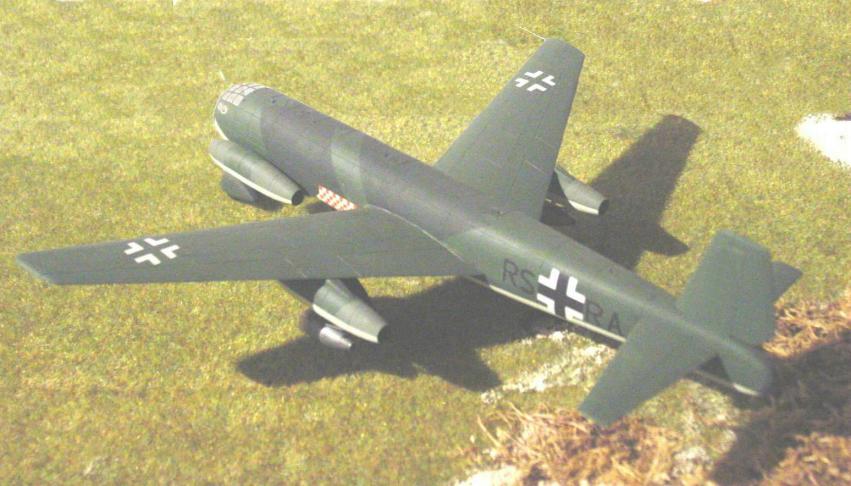
Junkers Ju 287 V-1
| Manufacturer: | Kit: | Quality: |
| HUMA | Junkers Ju 287 V-1 |
|
Um die Ju 287 V-1 zu verbessern, waren folgende Arbeiten nötig: Fast gar nichts, das wenige beschränkte sich auf die Bemalung. Aber schön langsam, immer der Reihe nach. Als das Modell vor etlichen Jahren auf den Markt kam, hatte ich natürlich schon den alten Vacu-Bausatz von Airmodel zu Hause. Natürlich habe ich mir den neuen trotzdem sofort besorgt. Und das war gut so. Wenn auch HUMA nur ein Kleinserienhersteller ist, so war der Bausatz dennoch erste Sahne. So filigrane Steuersäulen, Ruderpedale, etc. in Gußtechnik, gab es bislang noch nicht mal von Großserienproduzenten! Daß der Bausatz in der Bewertung dann bei 4 Sternen hängenblieb, liegt am gebrechlichen Fahrwerk. Aber dazu später mehr. Das Cockpit machte beim Zusammenbau keinerlei Schwierigkeiten, wie überhaupt die Paßform ganz hervorragend war. Nur ordentlich Gewicht kam in den Bug, denn trotz der vorwärts gepfeilten Tragflächen ist dieser große Bausatz hinten sehr schwer. Wie gesagt, das Fahrwerk war sehr zerbrechlich aufgebaut und meine damalige Skepsis hat sich bewahrheitet. Im Laufe der Jahre begann das rechte Hauptfahrwerk an der Stelle, wo das Rad auf der Welle sitzt, langsam nachzugeben und einzuknicken, wie auf dem Bild deutlich zu sehen ist. So steht das Ding jetzt erbärmlich schief da, und ich hab noch nicht den Mut gefunden, das zu reparieren. Ich fürchte, dabei mehr kaputtzumachen. Sogar die Kanzel war vorbildlich dünn und klar gegossen, sodaß es nicht nötig war, selbst eine neue zu ziehen. Die einzig knifflige Aufgabe war es, das karierte Rechteck mit dem Luftpinsel hinzubringen. Es erleichterte die Beobachtung der ausströmenden Gase aus dem Triebwerk. Diese winzige Schablone zu schneiden war ain hartes Stück Arbeit. Ansonsten war die Tarnung sehr leicht fertigzustellen. Die beiliegende Kennung war ebenfalls ausreichend dünn und anschmiegsam, sodaß dieser Bausatz wirklich nur wegen des heiklen Fahrwerks an der Bestnote haarscharf vorbeischrammte. Die V-1 hatte ihren Erstflug bereits am 16.08.1944 und wurde nur zu Testzwecken geflogen. In diesem Zustand, mit erst drei Starthilfsraketen, R-Geräte genannt, wurde das Flugzeug von den Sowjets 1945 nach Rußland abtransportiert. Mit ihm viele Techniker der Junkers-Werke, welche in den folgenden Jahren sogar noch weiter daran arbeiten mußten und schließlich noch einen dritten Prototyp bis zum Rollout brachten. |
To optimize the the Ju 287 V-1, following works were necessary: Nearly nothing; the few what had to be done concerned to the colouring. But slowly, I will tell you turn by turn. When this kit was delivered some years ago, I already owned the old vacu-kit made by Airmodel. Natrurally I bought the new one, too. And that was well done so. HUMA, in spite of being a short-run-manufactory, succeeded in making very sensitive rudder-pedals, control-columns, etc. even better than many of the other producers as Revell, Italeri, Hasegawa or Fujimi. This kit was cought at the 4th star in ranking because of its fragile main-landing-gear. Let me tell you later about it. There were no troubles in assembling the cockpit parts, as generally the fitting was exemplary. But I had to take care in adding enough wight into the nose, because this kit has most of its own wight in it's rear part in spite of the forward-swept wings. As already told, the landing-gear is a rickety one and my doubts in it's health became truth. When time was growing, the right main-gear showed its weakness at that point the wheel is added to the shaft. As can be clearly seen in the picture, the right landing-gear became truly knock-kneed and it looks like rather awfully, standing there so lop-sided. I did not dare to try a repair until today, I fear I could destroy more than to make it better. Even the canopy was molded very thin and clear, so there was no need to make a new one, self-made, vacu-canopy. The only difficulty was to do the checkered rectangle by airbrush. It made it much easier to observe the exhausting gas of the jet-engine. To cut this microscopic stencil was a hard piece of work. The rest of the camouflage was easy done. The decals, added in the box, were also smooth and thin enough, so this outraging kit missed the 5th star in ranking only by it's fragile main-gear. On August 08th, 1944, the Ju 287 V-1 had the first take-off. It's only prupose was to be flown as a test-bed. In this state of construction, as shown in the pictures, with only three auxiliary-starting-rockets added (so called R-Tools, R not for rocket, but for smoke - 'Rauch' in German - named so to fool hostile intelligence), the aircraft was conveyed to Russia in 1945. Many of the technologists of the Junkers aircraft industries were captured, too, and had to do further development on a third prototype which finally was lead to a roll-out. |
Further pictures